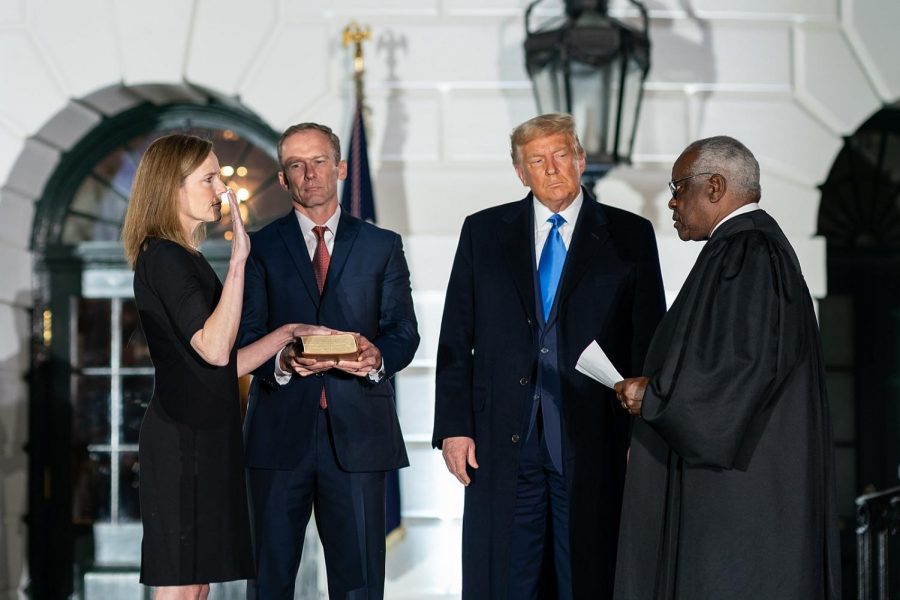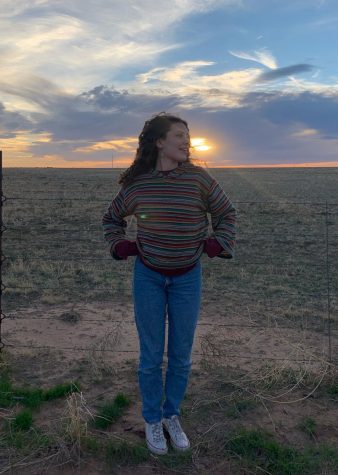Amy Coney Barrett Confirmed to Supreme Court as Election Court Fights Loom Large
President Donald Trump and Jesse Barrett look on as Supreme Court Justice Clarence Thomas administers the Constitutional Oath to Amy Coney Barrett on the South Lawn of the White House, Monday, Oct. 26, 2020.
November 3, 2020
Just a week before election day, on Monday, Oct. 26, Judge Amy Coney Barrett, American lawyer, jurist, and former academic, was confirmed to the American Supreme Court, filling the seat of recently passed Ruth Bader Ginsburg. The Senate voted 52-48 to confirm Ms. Barrett after four days of confirmation hearings, with all Democrats opposed and all but one Republican in favor. Her confirmation came 30 days after being nominated by President Donald Trump (R).
“The American people have been profoundly impressed to learn of her achievements, her compassion, her generosity, her faith, and her sterling character,” Mr. Trump said. “[They have] put their trust in you and their faith in you as you take up the task of defending our laws, our Constitution, and this country that we all love.”
Following the confirmation of her nomination, the White House held Barrett’s swearing-in ceremony on the night of her confirmation. Supreme Court Justice Clarence Thomas swore Ms. Barrett in under constitutional oath next to Mr. Trump, and her husband, Jesse Barrett. On the morning of Saturday, Oct. 24, Ms. Barrett recited the judicial oath in a separate, private ceremony at the Supreme Court, administered by Chief Justice John Roberts. This marked the beginning of her tenure as the 115th justice on the Supreme Court of the United States (SCOTUS). After taking the oath at the White House event, Ms. Barrett spoke about her belief that as a federal judge, she must separate her policy preferences from her decision making.
“A judge declares independence not only from Congress and the president but also from the private beliefs that might otherwise move her,” Ms. Barrett said. “The oath that I have solemnly taken tonight means at its core that I will do my job without any fear or favor.”
Ms. Barrett’s nomination overcame one of multiple hurdles on the afternoon of Sunday, Oct. 25, when the Senate voted to end debate on her nomination. Sunday’s vote occurred days after Democrats in the Senate boycotted a vote to advance Ms. Barrett’s nomination. Democrats in the Senate and across the country have been largely opposed to a confirmation being made so close to Election Day, seeing as the Republican-led senate in 2016 refused to hold hearings for President Barack Obama’s (D) nominee, Merrick Garland, eight months before Election Day.
“Nearly every Republican in this chamber led by the majority leader four years ago refused to even consider the Supreme Court nomination of a Democratic president on the grounds,” Senate Minority Leader Chuck Schumer (D) said. “We should wait until after the presidential election because the American people deserved a voice in the selection of their next justice.”
On Tuesday, Oct. 12, the second day of her confirmation hearings, Ms. Barrett proclaimed herself as an originalist, expressing that she interprets the U.S. Constitution based on its original understanding at the time it was written. This, as well as her views on issues such as abortion and gay marriage, have gained her support from social conservatives. Ms. Barrett is also a devout Catholic and a member of the Catholic group People of Praise, a group with strict views on human sexuality that embrace traditional gender norms. With Ms. Barrett confirmed, the court now has a six-three conservative majority.
“There are serious and deep concerns about Judge Amy Coney Barrett’s affiliation with People of Praise and her past comments about the conflict between faith and law,” Andrew Seidel, constitutional attorney with the Freedom From Religion Foundation, said. “Not only is her connection to this community and her previous writings fair to ask about, but senators have a duty to the constitution to ask those questions.”
With Ms. Barrett officially a Supreme Court justice, there are several cases coming up that she will now be on the bench for. On Tuesday, Nov. 10, a week after Election Day, the Supreme Court will hear a Trump-backed challenge to the Affordable Care Act, also known as Obamacare. A past ruling by Ms. Barrett on Obamacare has alarmed advocates of the healthcare program, seeing that she could cast a decisive vote. Her past writings on abortion have also concerned liberal groups and triggered warnings that the 1973 Supreme Court case Roe v. Wade, that elegalised abortion nationwide, could be overruled. Despite the angst that she may allow her conservative views to overstep into her decisions, Ms. Barrett attempted to present herself as neutral throughout the hearings when it came to topics up for political debate, by refusing to answer questions that would showcase her personal beliefs.
“Judges can’t just wake up one day and say, ‘I have an agenda, I like guns, I hate guns, I like abortion, I hate abortion,’ and walk in like a royal queen and impose their will on the world,” Ms. Barrett said. “Whether I say I love it or I hate it, it signals to litigants that I may tilt one way or another in a pending case.”
Ms. Barrett has been Mr. Trump’s third appointee to the Supreme Court. If Democratic presidential candidate Joe Biden wins the upcoming election, he won’t have the ability to simply reverse her confirmation if he wished to. With her now established presence, the majority conservative wing of the court could reshape American laws and the rights of marginalized groups, for generations to come.



